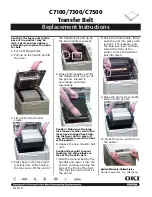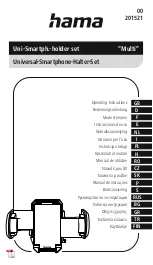
WWW.BALTIMOREAIRCOIL.COM
17
• With the design thermal load and the average water pressure (15 to 50 psig) at the
valve, the above setting will produce operating water levels as stated in
Table 1
on
page 10
.
• If the thermal load is less than the design load at the time of unit start-up, the
procedure may produce operating levels greater than those shown in
Table 1
. If
operating levels are higher than specified, readjust the float in order to attain the
recommended operating level.
• Closely monitor the water level in the cold water basin and adjust the level if necessary
during the first 24 hours of operation.
• Operating at the recommended water level will ensure that the unit basin contains
sufficient water volume to prevent air entrainment in the circulating pump during
system start-up and provides sufficient excess basin capacity to accept the total
system pull-down volume.
Optional Electric Water Level Control Package
As an option, an electric water level control package is available in lieu of the mechanical
make-up assembly. The package consists of a probe-type liquid level control assembly
and a slow-closing solenoid valve. Stainless steel electrodes, factory-set at predetermined
lengths, extend from an electrode holder into the cold water basin. For more information,
refer to the
Electric Water Level Control Operation & Maintenance Manual
available at
www.BaltimoreAircoil.com.
• Clean the stainless steel electrodes periodically to prevent accumulations of scale,
corrosion, sludge, or biological growth, which could interfere with the electrical circuit.
• The water level is maintained at the recommended operating level regardless of the
system thermal load. Therefore, it is not recommended that the operating level be
adjusted.
• During the start-up of units equipped with the electric water level control package,
bypass the control unit in order to fill the unit to the overflow connection.
L.E.D. Status Codes
•
L.E.D. on steady
: Indicates normal operation.
•
Steady one second flashing:
Indicates dirty probes, reading in the capacitance mode.
The unit will still operate but will give the following status code of 1 second on, 1
second off (steady 1 second flashing). This status code continue until the probes are
cleaned and the power has been reset. Note: No other status codes will be displayed
until the dirty probes are cleaned.
•
Two flashes and off for 5 seconds
: Indicates make-up valve ran for more than 1 hour.
The unit will continue to fill, with the following status code of 1 second on, 1 second
off, 1 second on and then off for 5 seconds before repeating. This status will continue
until power has been reset.
Possible causes
: leaking tank, obstructed fill / defective
valve or reduced flow rate.
•
Three flashes and off for 5 seconds
: Indicates shorted probes or highly conductive
water. The unit will continue to operate but will give the following status code of 1
second on, 1 second off, 1 second on, 1 second off, 1 second on and then off for 5
seconds before repeating. This status will continue until the water is diluted or the
short is removed from the probes and power is reset.
•
Four flashes and off for 5 seconds
: Indicates black probe (P6) reads covered, but
white probe (P5) does not read covered (white should also be covered because it is
longer than the black). This will cause the fill solenoid valve to short cycle and lead to
premature failure of the fill valve. The unit will short cycle and give the status code of
1 second on, 1 second off, 1 second on, 1 second off, 1 second on, 1 second off, 1
second on and then off for 5 seconds before repeating. The unit will continue to short
cycle until the condition has been corrected (clean white probe) and the power reset.
•
L.E.D. does not come on after power up or resetting power
: Indicates unit inoperative.
Detailed Component
Maintenance
Procedures
Water Distribution and Heat
Transfer Section
Water Level Control
Mechanical Make-up Valve
Assembly
Optional Electric Water Level
Control Package
















































